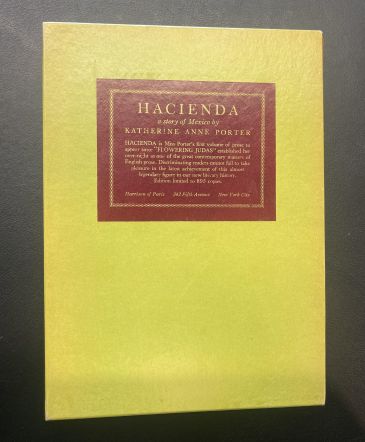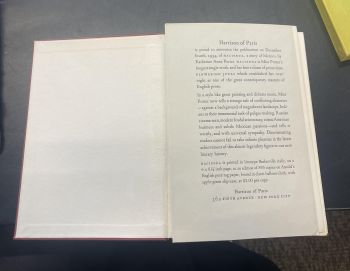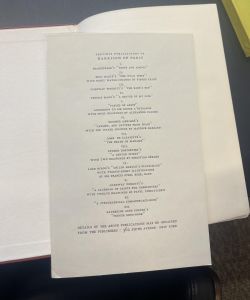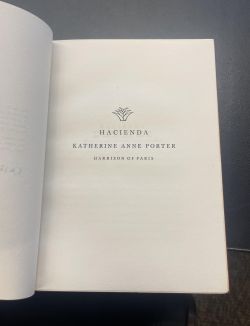Hacienda

Overview
Hacienda by Katherine Anne Porter is a richly layered short novel that provides a poignant glimpse into the aftermath of the Mexican Revolution. Published in 1934, this finely crafted work draws from Porter's own experiences living in Mexico, blending personal observation with fictional narrative. Through the eyes of an unnamed young woman visiting a decaying hacienda, Porter deftly explores themes of cultural upheaval, fading traditions, and the tensions between the old feudal order and modern social reform.
Historical Background and Significance
Katherine Anne Porter
Katherine Anne Porter (1890-1980) was an American journalist, essayist, short story writer, novelist, and political activist. She is known for her powerful and precise prose style and for her exploration of themes such as human nature, morality, and the complexities of human relationships. Her work often delved into themes of justice, betrayal, and the unforgiving nature of the human spirit. Porter’s writing career began in the 1920s when she worked as a journalist and published her first short stories. Her first major work was the critically acclaimed short story collection Flowering Judas and Other Stories (1935), which established her reputation as a significant literary voice.[1] This collection reflects her observations and experiences in Mexico, where she lived for several years during the 1920s. The Mexican influence is significant throughout her work, often focusing on themes of struggle, political turmoil, and personal betrayal.
Historical Context
Hacienda is a short novel or long short story that, although a fictional work, Porter wrote based on her experiences living in Mexico in the 1920s.The story centers around a young woman who witnesses the aftermath of the Mexican Revolution while staying at a hacienda. Porter drew inspiration for Hacienda from her time working as a journalist in Mexico City and personally witnessing the aftermath of the Mexican Revolution. The story reflects her interest in exploring the complexities of cultural identity and the impact of political upheaval, and it explores themes of revolution, violence, and the clash between traditional and modern values.
Significance
Set against the backdrop of the Mexican Revolution, Hacienda reflects the complex socio-political dynamics of early 20th-century Mexico, serving as a crucial narrative that captures the essence of a pivotal historical moment. This novel both enriches the historical understanding of the period and exemplifies Porter’s deep engagement with the political upheavals of her time, mirroring her other works that often blend personal experiences with broader historical events.[2] Additionally, "Hacienda" contributes to the history of authorship by showcasing Porter's distinctive narrative style and her adeptness at interweaving personal and historical themes. This skill places her work in a significant position within American literature, particularly in the genre of historical fiction that seeks to illuminate past events through a nuanced, literary lens.[3] For its copyright history, as with many of her works from the mid-20th century, Hacienda underscores the evolving nature of copyright laws that were adapting to the burgeoning print culture, reflecting ongoing changes in how literary works were protected and circulated during Porter’s lifetime.
Material Analysis
Provenance

This copy of Hacienda was acquired by the University of Pennsylvania Libraries in 2014 as part of the Schimmel Collection, and it is housed in the Kislak Center for Special Collections, Rare Books, and Manuscripts. The Schimmel Collection was donated by Caroline F. Schimmel and consists of books about the American West. This specific copy is numbered 564 out of 894 copies in the edition, indicating its rarity and value as a fine press book. Its provenance can be traced back to its publication in 1934 by Harrison of Paris, Inc., a renowned publisher of limited-edition books.
Substrate, Format, and Binding

The book is printed on Arnold English unbleached pure rag paper, also known as cotton paper, which was a high-quality paper commonly used for fine press books in the early 20th century. Rag paper, made from cotton or linen rags, was prized for its durability, distinctive texture, and superior printing qualities compared to that of wood-pulp paper. According to The Oxford Companion to the Book, rag paper was favored by fine press printers and bibliophiles for its longevity and aesthetic appeal. The use of unbleached rag paper in this edition again adds to its artisanal quality and ensures that the book will remain in excellent condition for years to come.
Hacienda is a fine press printed book, which means it was produced with exceptional care and attention to detail, often by hand or with specialized equipment. Fine press books were created as works of art, prized for their high-quality materials, expert craftsmanship, and limited print runs.[4] The book is a hardcover volume, measuring 6 ½ x 8 inches, which would have been considered a convenient and portable size for readers in the 1930s. It is bound in claret-balloon cloth, a type of binding material popular at the time, with a gold-colored top edge to the text block. The book is also sewn bound, which is a durable and traditional binding method that allows the book to open flat and withstand frequent use. The sewn binding, along with the high-quality materials used, contribute to the book’s lasting value as a collectible item.
Textual Analysis
Paratexts
The book contains several notable paratexts that provide context and enhance the reading experience. First, there is a foreword in the form of a folded advertisement from the publisher, Harrison of Paris, Inc. This advertisement serves as a preface, introducing the author and the work, as well as providing details about the book's production, such as the font, paper, and binding. Additionally, there is a separate page before the title page that includes information about the book's designer, Monroe Wheeler, the copy number (564 out of 895), and Katherine Anne Porter's signature. This paratext adds a sense of exclusivity and uniqueness to each individual copy. Porter also includes a preface in which she clarifies that the characters and situations in the story are entirely fictional, setting the stage for the reader's interpretation of the work. These paratexts not only provide valuable context but also contribute to the book's status as a fine press, limited edition work, elevating it beyond a mere reading copy.

The book includes several features that aid in navigation and enhance the reading experience. As a fine press book, it was designed with the expectation that readers would approach it as a work of art, savoring the physical object as much as the content. One notable navigation element is the apple-green slipcase that houses the book. This slipcase not only protects the book but also creates a sense of ceremony around accessing the text, requiring the reader to remove the book from its protective casing before beginning their journey through the story. The folded advertisement from the publisher, which serves as a foreword, provides context and introduces the reader to the book's production and purpose. Additionally, the separate page with the designer's name, copy number, and author's signature further establishes a sense of exclusivity and invites the reader to appreciate the book as a carefully crafted object. These navigation mechanisms, combined with the high-quality materials and attention to detail in the book's production, suggest that the reader was expected to approach Hacienda with a sense of reverence and appreciation for the artistry involved in its creation.
Readership & Circulation
Hacienda would have circulated primarily through traditional print publishing routes of the mid-20th century, including bookstores and libraries. Given her status as an established author by the time Hacienda was released, the book likely enjoyed a broad distribution network facilitated by her publishers, who capitalized on her previous successes such as Ship of Fools and The Collected Stories of Katherine Anne Porter. Porter’s readership consisted of a literate, often well-educated audience that had an interest in finely crafted narratives and deep psychological and social themes. Her works appealed to those who appreciated literary fiction and were interested in the complexities of personal and historical narratives. It would have also attracted readers interested in historical fiction and those seeking to understand the cultural and political nuances of Mexico during this turbulent period.
References
- ↑ Brittanica, The Editors of Encyclopaedia. "Katherine Anne Porter", (Encyclopedia Britannica, 2 Apr. 2024).
- ↑ Porter, Katherine Anne & Givner, Joan. Katherine Anne Porter Conversations, (Jackson: University Press of Mississippi, 1987).
- ↑ Unrue, Darlene Harbour. Understanding Katherine Anne Porter, (Columbia, S.C.: University of South Carolina Press, 1988).
- ↑ Hazel, Alexa. Book History, ""You Shall Look at This or at Nothing": Gaylord Schanilec and the Value of the Fine Press Book", (Baltimore: Johns Hopkins University Press, 2021), 146-176.




